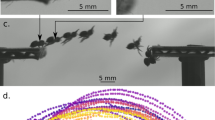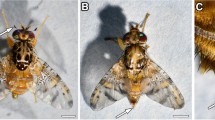Abstract
The Indian antHarpegnathos saltator may be unique among insects in using its jumping capacity not only as an escape mechanism but also as a normal means of locomotion, and for catching its prey in flight. High-speed cinematography used to analyse the various phases of the jump suggests thatHarpegnathos employs a novel jumping mechanism to mediate these behaviours: namely the synchronous activation of its middle and hindlegs. Electrophysiological recordings from muscles or nerves in pairs of middle and hindlegs show remarkably synchronous activity during fictive jumping, supporting the synchronous activation hypothesis.Harpegnathos is not the only ant to jump, and a cladistic analysis suggests that jumping behaviour evolved independently three times during ant evolutionary history.
Similar content being viewed by others
References
Jerdon, T. C., Madras J. Lit. Sci.17 (1851) 103.
Lewis, G., L'Abeille2 (1882) 155.
Lefèvre, E., Bull. trim. Soc. Ent. France (1883) LXXXIII.
Wroughton, R. C., J. Bombay nat. Hist. Soc.7 (1892) 13.
Bingham, C. T., The fauna of British India, including Ceylon and Burma. Hymenoptera, Vol. II. Taylor and Francis, London 1903.
Soans, A. B., and Soans, J. S., J. Bombay nat. Hist. Soc.69 (1969) 668.
Musthak Ali, T. M., Baroni Urbani, C., and Billen, J., Naturwissenschaften79 (1992) 374.
Maschwitz, U., Hahn, M., and Schönegge, P., Naturwissenschaften66 (1979) 213.
Bennett-Clark, H. C., and Lucey, E. C. A., J. exp. Biol.47 (1967) 59.
Rothschild, M., Schlein, Y., Parker, K., and Sternberg, S., Nature239 (1972) 45.
Rothschild M., Schlein, Y., Parker, K., Neville, C., and Sternberg, S., Scient. Am.229 (1973) 92.
Hoyle, G., Scient. Am.198 (1958) 30.
Bennett-Clark, H. C., J. exp. Biol.63 (1975) 53.
Heitler, W. J. and Burrows, M., J. exp. Biol.66 (1977) 203.
Heitler, W. J., and Burrows, M., J. exp. Biol.66 (1977) 221.
Pearson, K. G., J. Physiol., Paris,78 (1982–3) 765.
Emergy, C., Biol. Zbl.13 (1983) 189.
Forel, A., Le monde social des fourmis comparé à celui de l'homme, Vol. I. Kundig, Geneva 1921.
Maschwitz, U., in: Neurobiology and strategies of adaptation. Joint Symposium, The Hebrew University of Jerusalem —Université Lyon — Universität Frankfurt a. M. (1981).
Wheeler, W. M., Biol. Bull.42 (1922) 185.
Wesson, L. G., Ent. News47 (1936) 171.
Wheeler, W. M. Colony-founding among ants with an account of some primitive Australian species. Harvard Univ. Press., Cambridge, Mass. 1933.
Kempf, W. W., and Lenko, K., Papéis avulsos de Zoologia, S. Paulo21 (1968) 209.
Via, S. E., J. comp. Physiol.121 (1977) 33.
Hoyle, G., Proc. R. Soc. (B.)143 (1955) 343.
Evans, M. E. G., J. Zool.169 (1973) 181.
Bennet-Clark, H. C., in: The insect integument. Ed. H. R. Hepburn. Elsevier, Amsterdam 1980.
Pearson, K. G., and Robertson, R. M., J. comp. Physiol.144 (1981) 391.
Stitz, H., in: Tabulae biologicae periodicae, pp. 208–280, Eds C. Oppenheimer and L. Pincusson. W. Junk, Den Haag 1937.
Bernard, F., Bull. biol. Fr. Belg., Suppl., 1937.
Menzel, R., and Wehner, R., Z. vergl. Physiol.68 (1970) 446.
Baroni Urbani, C., Ins. Soc.40 (1993) 233.
Baroni Urbani, C., Bolton, B., Ward, P. S., Syst. Ent.17 (1992) 301.
Maddison, W. P., and Maddison, D. R., MacClade: analysis of phylogeny and character evolution. Version 3. Sinauer Associates, Sunderland, Mass. 1992.
Author information
Authors and Affiliations
Rights and permissions
About this article
Cite this article
Urbani, C.B., Boyan, G.S., Blarer, A. et al. A novel mechanism for jumping in the indian antHarpegnathos saltator (Jerdon) (Formicidae, Ponerinae). Experientia 50 (Suppl 1), 63–71 (1994). https://doi.org/10.1007/BF01992052
Received:
Accepted:
Issue Date:
DOI: https://doi.org/10.1007/BF01992052




